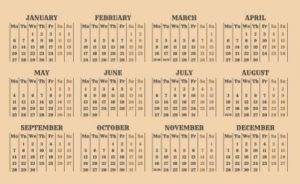
Why are there 52 weeks in a year and not 48 weeks given that there are only 4 weeks per month (4 x 12 = 48)?
The most important thing to understand regarding this is that time is a man-made construct. We divided time into seconds, minutes, hours, days, months, and, years to understand the “solar day”. This is a complex equation to understand, but we will break it down to understand it better.
The exact division of time has not been possible and to make it easier for our understanding it is crucial to divide it evenly. We look at it in more detail to understand, now. As there are 12 months in a year, the question asked is how many weeks are in a month? The commonly known answer is four. However, the number of days in a week is seven so if you multiply the number of days with the number of weeks, you get 28 days, only. That is definitely a problem. There are seven months in a year that have 31 days and at the same time there are four months in a year that have 30 days. That leaves February as the only month which has 28 days and even February has 29 days in a leap year. So, while it is easier to have four weeks, it is obviously not an accurate representation of the number of weeks that are in a month.

So, when you multiply four (weeks) with 12 (months) you get 48 weeks. However, when you divide 31 days with 7 you get 4.42 weeks. Similarly, when we divide 30 days with 7, we get 4.28 weeks. This is why when we calculate how many weeks are in a year, we get 52 because the figure is not exactly four weeks per month, it is slightly re than that. At the end of the year all of that adds up and we get 52 weeks instead of 48 weeks. What is 52 weeks in months? This is another important question.
Like I mentioned before, all of this was done in order to make it easier for us to understand. Another way to look at it is to multiply the number of weeks, 48, with 7, the number of days in each week and we will get the figure 336. Now, we know that the Earth completes its orbit around the sun in 365 days. 365 days are what amount to a year. Having 336 days would be around 29 days short of the solar orbit. There was an obvious solution, why not just add an extra month? However, there is a belief that the number 13 is considered unlucky in many religions and ideologies so it was not considered as the right call.
We could choose to elongate the day or the week, too. However, even the current day is not exactly 24 hours as we believe it is. The exact duration of a day is 23 hours 56 minutes and 4 seconds. Again, that would not be possible and it would not end up being a wholly figure at the end of the day and at the end of the year. A more relative question can be how many working weeks are in a year? The number of working weeks is also the same, but it varies in each job, as well. While vacation days are not included but the norm is that Christmas and the New Year are considered to be two weeks off the year. Some employers offer two more weeks off for Easter and summer, as well. So, you can say the total number of workweeks is 48.
This does raise the question if each year has the same number of weeks. How many weeks were in 2019? The answer is 52. Every year has the same number of weeks. However, every year also has one extra day at the end of it. As for the leap years, they have 52 weeks, too. The number of extra days in a leap year is 2, as the total number of days in a leap year is 366, which is one more than the normal year which has 365 days.
In conclusion, if we just skip the numbers and the technical details, we can understand all of this in a much simpler way. Time is not rigid and it is based on the movement of our planet which orbits around the sun in a given duration. We have, for our own ease, managed to mark that duration and divide for our own convenience into minutes, days, weeks, months, years, and decades. When we divide it to find the accurate duration of these figures, we find out that there is some kind of anomaly. The day is not actually 24 hours long, it is slightly lesser than the 24-hour figure. The number of weeks in a month is seven but over a year this figure adds up to 52. The months can range from 28 days to 31 days long. What we learn from all this calculation is that while the numbers are not accurate, the priority was the ease and convenience of the humans in understanding time and the way it is divided for us. There were other factors, too, like I mentioned above.
Religion and our superstitions played a huge role in this, as well. As in Japan, most buildings skip making floor number 13. This is just to avoid any bad luck. The number 13 is considered unlucky in many cultures. Just like the number 7 is considered to be very lucky. These things are somehow considered, even, when the data is calculated on the basis of science and logic. However, when it is being implemented on the entire human population it is important to acknowledge their likenesses and beliefs and to incorporate it into these findings. So, basically, the priority is ease, comfort, and commonly held beliefs. Rounding off to whole numbers was the most important factor behind this.




